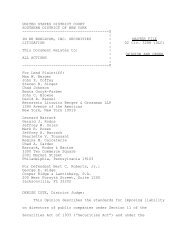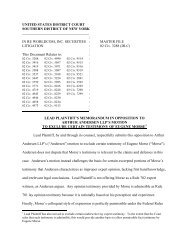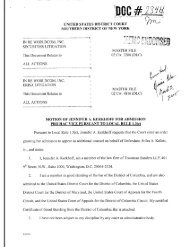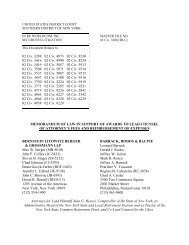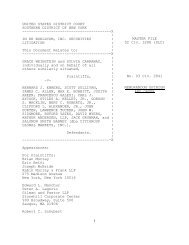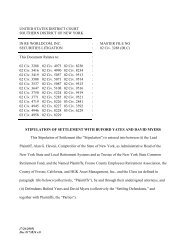Lead Plaintiff's Memorandum of Law in Opposition to Defendants'
Lead Plaintiff's Memorandum of Law in Opposition to Defendants'
Lead Plaintiff's Memorandum of Law in Opposition to Defendants'
Create successful ePaper yourself
Turn your PDF publications into a flip-book with our unique Google optimized e-Paper software.
are negligence-based, rather than fraud-based, and need not satisfy the Rule 9(b) requirement that<br />
fraud claims be stated with particularity. In recognition <strong>of</strong> the elements that a pla<strong>in</strong>tiff must plead <strong>to</strong><br />
state a Section 11 claim, 345 <strong>of</strong> the Compla<strong>in</strong>t (and other paragraphs relat<strong>in</strong>g <strong>to</strong> the Securities Act<br />
claims) states <strong>in</strong> relevant part: “This claim does not sound <strong>in</strong> fraud, and pla<strong>in</strong>tiffs do not <strong>in</strong>corporate<br />
here<strong>in</strong> any allegations <strong>of</strong> fraud <strong>in</strong> connection with this Count.” As a result, pla<strong>in</strong>tiffs were not required <strong>to</strong><br />
plead their Section 11 claims as though they were fraud claims covered by Rule 9(b). See, e.g., Lone<br />
Star Ladies Inv. Club v. Schlotzsky’s Inc., 238 F.3d 363, 368-69 (5th Cir. 2001); In re NationsMart<br />
Corp. Sec. Litig., 130 F.3d 309, 314-15 (8th Cir. 1997); accord In re AnnTaylor S<strong>to</strong>res Sec. Litig.,<br />
807 F. Supp. 990, 1003 (S.D.N.Y. 1992) (Motley, J.) (“Because pro<strong>of</strong> <strong>of</strong> fraud is not necessary <strong>to</strong><br />
prevail on a Section 11 claim . . . courts have long held that Rule 9(b) does not apply <strong>to</strong> a Section 11<br />
claim. . . . The same holds true when pla<strong>in</strong>tiffs have raised a separate claim for fraud under Section<br />
10(b).”) (citations omitted). 12 Accord<strong>in</strong>gly, the Section 11 claims <strong>in</strong> Counts I, III, and IV must be<br />
susta<strong>in</strong>ed as <strong>to</strong> all Defendants named there<strong>in</strong>.<br />
B. The Compla<strong>in</strong>t Properly Asserts All Securities Act Claims on Behalf <strong>of</strong> the Class<br />
After the news <strong>of</strong> problems at WorldCom began <strong>to</strong> break, several dozen class actions were<br />
filed <strong>in</strong> federal courts throughout the country, <strong>in</strong>clud<strong>in</strong>g n<strong>in</strong>eteen cases filed <strong>in</strong> this District. Several <strong>of</strong><br />
these actions were <strong>in</strong>itiated by purchasers <strong>of</strong> WorldCom bonds who alleged, among other th<strong>in</strong>gs, that<br />
Counts IV and V <strong>of</strong> the Consolidated Compla<strong>in</strong>t.<br />
12<br />
In any event, even if one were <strong>to</strong> apply Rule 9(b) <strong>to</strong> Count I, the Compla<strong>in</strong>t more than<br />
adequately asserts facts sufficient <strong>to</strong> support the claim aga<strong>in</strong>st Ebbers. The Compla<strong>in</strong>t sets forth <strong>in</strong><br />
detail the materially false and mislead<strong>in</strong>g statements and omissions that form the basis <strong>of</strong> the Section 11<br />
claim, why those statements and omissions were false and mislead<strong>in</strong>g, the documents <strong>in</strong> which the<br />
statements and omissions appeared, who made the statements and failed <strong>to</strong> state the material<br />
<strong>in</strong>formation omitted, and the reasons the statu<strong>to</strong>ry defendants are liable under Section 11 for the<br />
specifically identified false statements and omissions.<br />
-28-



